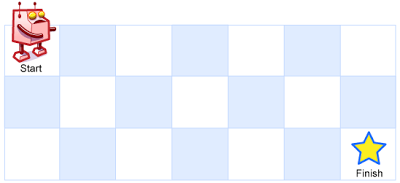#62 - Unique Paths
Unique Paths
- Difficulty: Medium
- Topics: Math, Dynamic Programming, Combinatorics
- Link: https://leetcode.com/problems/unique-paths/
Problem Description
There is a robot on an m x n grid. The robot is initially located at the top-left corner (i.e., grid[0][0]). The robot tries to move to the bottom-right corner (i.e., grid[m - 1][n - 1]). The robot can only move either down or right at any point in time.
Given the two integers m and n, return the number of possible unique paths that the robot can take to reach the bottom-right corner.
The test cases are generated so that the answer will be less than or equal to 2 * 109.
Example 1:

Input: m = 3, n = 7
Output: 28
Example 2:
Input: m = 3, n = 2
Output: 3
Explanation: From the top-left corner, there are a total of 3 ways to reach the bottom-right corner:
1. Right -> Down -> Down
2. Down -> Down -> Right
3. Down -> Right -> Down
Constraints:
1 <= m, n <= 100
Solution
1. Problem Deconstruction
Technical Restatement:
Given an m x n grid, compute the number of distinct paths from (0,0) to (m-1,n-1) using only right/down moves. Formally, find the cardinality of the set of all valid move sequences.
Beginner Explanation:
Imagine a grid where you start at the top-left corner. You can only move right or down. How many different ways can you reach the bottom-right corner without backtracking?
Mathematical Formulation:
The problem reduces to counting unique permutations of (m-1) downward and (n-1) rightward moves. The solution is the binomial coefficient:
Constraint Analysis:
1 <= m, n <= 100:- Limitation: Brute-force recursion (O(2^(m+n))) is computationally infeasible.
- Edge Case: When
m=1orn=1, only 1 path exists (straight line).
- Answer <= 2e9:
- Implication: Avoid floating-point inaccuracies in combinatorial calculations.
2. Intuition Scaffolding
Analogies:
- City Navigation: Like taxis in Manhattan taking shortest routes via grid streets.
- Game Strategy: Chess rook moving only south/east to reach a target square.
- Math Puzzle: String permutations of “D” and “R” with fixed character counts.
Common Pitfalls:
- Recursive DFS without memoization: Exponential time complexity.
- Breadth-First Search (BFS): Queue size explodes for large grids.
- Initializing DP grid incorrectly: First row/column should be all 1s.
- Integer overflow in combinatorial calculations: Multiplying large factorials naively.
- Assuming diagonal moves: Robot can’t move diagonally per problem constraints.
3. Approach Encyclopedia
1. Brute-Force Recursion:
def uniquePaths(m, n):
if m == 1 or n == 1:
return 1
return uniquePaths(m-1, n) + uniquePaths(m, n-1)
- Time: O(2^(m+n)) – Binary recursion tree depth.
- Space: O(m+n) – Call stack depth.
2. Dynamic Programming (2D):
dp = [[1]*n for _ in range(m)]
for i in 1 to m-1:
for j in 1 to n-1:
dp[i][j] = dp[i-1][j] + dp[i][j-1]
return dp[-1][-1]
- Time: O(mn) – Filling all grid cells.
- Space: O(mn) – Storing full grid.
Visualization:
Initial Grid (3x3):
1 1 1
1 0 0
1 0 0
Final Grid:
1 1 1
1 2 3
1 3 6 → Answer=6
3. Space-Optimized DP (1D):
dp = [1] * n
for i in 1 to m-1:
for j in 1 to n-1:
dp[j] += dp[j-1]
return dp[-1]
- Time: O(mn) – Same as 2D DP.
- Space: O(n) – Single row storage.
4. Combinatorial Formula:
from math import comb
return comb(m+n-2, m-1)
- Time: O(min(m,n)) – Multiplicative loop iterations.
- Space: O(1) – Constant variables.
Multiplicative Implementation:
a = m + n - 2
b = min(m-1, n-1)
result = 1
for i in 1..b:
result = result * (a - b + i) // i
return result
4. Code Deep Dive
Optimal Solution (Combinatorial):
def uniquePaths(m: int, n: int) -> int:
a = m + n - 2
b = min(m-1, n-1)
result = 1
for i in range(1, b+1):
result = result * (a - b + i) // i
return result
Line-by-Line:
a = m + n - 2→ Total moves needed.b = min(...)→ Optimize calculation by choosing smaller factorial.resultinitialized to 1 → Identity for multiplication.- Loop computes numerator incrementally while dividing by
i→ Prevents overflow.
Edge Case Handling:
m=1→b=0, loop skipped → Returns 1.- Division at each step → Ensures integer arithmetic.
5. Complexity War Room
Hardware Considerations:
- Combinatorial approach uses 32-bit integers safely (answer <=2e9).
- DP approaches fit in L1 cache for m,n=100 (grid size=10,000 → ~40KB).
Approach Comparison:
| Method | Time | Space | Readability | Viability |
|---|---|---|---|---|
| Brute Force | O(2^N) | O(N) | 5/10 | ❌ |
| 2D DP | O(mn) | O(mn) | 9/10 | ✅ |
| 1D DP | O(mn) | O(n) | 7/10 | ✅ |
| Combinatorial | O(k) | O(1) | 6/10 | ✅★ |
6. Pro Mode Extras
Variants:
- Obstacles in Grid (LC 63): Use DP with obstacle checks.
- Multiple Transactions (LC 123): Extend DP to track state.
Interview Tips:
- First Mention: “The optimal solution uses combinatorics with O(1) space.”
- Edge Case: Always check for grids with zero width/height (but constraints prevent this here).
- Tradeoffs: “DP is more intuitive but combinatorial is optimal for large grids.”